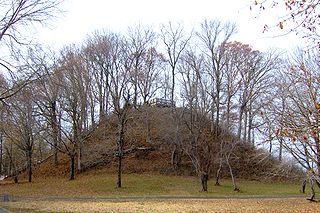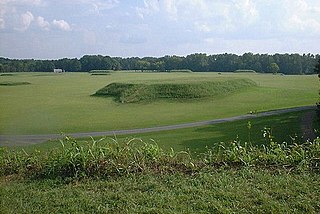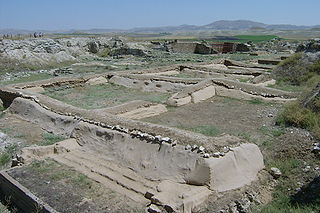
The Civilian Conservation Corps (CCC) was a voluntary public work relief program that operated from 1933 to 1942 in the United States for unemployed, unmarried men. Originally for young men ages 18–25, it was eventually expanded to ages 17–28. Robert Fechner was the first director of this agency, succeeded by James McEntee following Fechner's death. The CCC was a major part of President Franklin D. Roosevelt's New Deal that provided unskilled manual labor jobs related to the conservation and development of natural resources in rural lands owned by federal, state, and local governments. The CCC was designed to provide jobs for young men and to relieve families who had difficulty finding jobs during the Great Depression in the United States. Maximum enrollment at any one time was 300,000. Through the course of its nine years in operation, 3 million young men participated in the CCC, which provided them with shelter, clothing, and food, together with a wage of $30 per month.

The Cahokia Mounds State Historic Site is the site of a pre-Columbian Native American city directly across the Mississippi River from modern St. Louis, Missouri. This historic park lies in southern Illinois between East St. Louis and Collinsville. The park covers 2,200 acres (890 ha), or about 3.5 square miles (9 km2), and contains about 80 mounds, but the ancient city was much larger. At its apex around 1100 CE, Cahokia covered about 6 square miles (16 km2) and included about 120 manmade earthen mounds in a wide range of sizes, shapes, and functions. In population, it may have briefly exceeded contemporaneous London.

Beloit College is a private liberal arts college in Beloit, Wisconsin. Founded in 1846, while the state of Wisconsin was still a territory, it is the oldest continuously operated college in the state. It is a member of the Associated Colleges of the Midwest and has an enrollment of roughly 1,402 undergraduate students.

The Pinson Mounds comprise a prehistoric Native American complex located in Madison County, Tennessee in the region that is known as the Eastern Woodlands. The complex, which includes 17 mounds, an earthen geometric enclosure, and numerous habitation areas, was most likely built during the Middle Woodland period. The complex is the largest group of Middle Woodland mounds in the United States. Sauls' Mound, at 72 feet, is the second-highest surviving mound in the United States.

Wickliffe Mounds is a prehistoric, Mississippian culture archaeological site located in Ballard County, Kentucky, just outside the town of Wickliffe, about 3 miles (4.8 km) from the confluence of the Ohio and Mississippi rivers. Archaeological investigations have linked the site with others along the Ohio River in Illinois and Kentucky as part of the Angel Phase of Mississippian culture. Wickliffe Mounds is controlled by the State Parks Service, which operates a museum at the site for interpretation of the ancient community. Listed on the National Register of Historic Places, it is also a Kentucky Archeological Landmark and State Historic Site.

Moundville Archaeological Site, also known as the Moundville Archaeological Park, is a Mississippian culture site on the Black Warrior River in Hale County, near the city of Tuscaloosa, Alabama. Extensive archaeological investigation has shown that the site was the political and ceremonial center of a regionally organized Mississippian culture chiefdom polity between the 11th and 16th centuries. The archaeological park portion of the site is administered by the University of Alabama Museums and encompasses 185 acres (75 ha), consisting of 29 platform mounds around a rectangular plaza.

Key Marco was an archaeological site (8CR48) consisting of a large shell works island next to Marco Island, Florida. A small pond on Key Marco, now known as the "Court of the Pile Dwellers," (8CR49) was excavated in 1896 by the Smithsonian Institution's Pepper-Hearst Expedition, led by Frank Hamilton Cushing. Cushing recovered more than 1,000 wooden artifacts from the pond, the largest number of wooden artifacts from any prehistoric archaeological site in the eastern United States. These artifacts are described as some of the finest prehistoric Native American art in North America. The Key Marco materials are principally divided between the University of Pennsylvania Museum of Archaeology and Anthropology, University of Pennsylvania; the Department of Anthropology, National Museum of Natural History, Smithsonian Institution; and the Florida Museum of Natural History, University of Florida. The original pond was completely excavated and refilled. It is now covered by a housing subdivision. Excavations of small parts of the site were also conducted in 1965 and 1995..

The Naples Mound 8 is a Havana Hopewell culture mound site located in Pike County, Illinois three miles east of the city of Griggsville. The mound was given the name Naples Mound #8 in 1882. The mound was listed on the National Register of Historic Places in 1975.

Henry Town, Henry Towne, or Henries Towne was an early English colonial settlement near Cape Henry, the southern point and gateway to the Chesapeake Bay in the Colony and Dominion of Virginia, now in modern Virginia Beach, Virginia, on the East Coast of the United States. Archaeologist Floyd Painter of the Norfolk Museum of Arts and Sciences originally excavated the site in 1955, but it was only conclusively determined to be Henry Town in 2007 by United States Army scientists reviewing the site's artifacts, and no primary source documents exist. It was located east of Norfolk, Virginia and north of Chesapeake and south of the Hampton Roads harbor at approximately 36°54′30″N76°7′20″W. The historical and archeological site is immediately north of U.S. Route 60 on what is now Lake Joyce, formerly an inlet connecting with Pleasure House Creek, a western branch of the Lynnhaven River, itself an estuary of the Chesapeake Bay and Hampton Roads.

Rock Eagle Effigy Mound is an archaeological site in Putnam County, Georgia, U.S. estimated to have been constructed c. 1000 BC to AD 1000. The earthwork was built up of thousands of pieces of quartzite laid in the mounded shape of a large bird. Although it is most often referred to as an eagle, scholars do not know exactly what type of bird the original builders intended to portray. It is listed on the National Register of Historic Places (NRHP) because of its significance. The University of Georgia administers the site. It uses much of the adjoining land for a 4-H camp, with cottages and other buildings, and day and residential environmental education.

The Anna Site is a prehistoric Plaquemine culture archaeological site located in Adams County, Mississippi 10 miles (16 km) north of Natchez. It is the type site for the Anna Phase of the Natchez Bluffs Plaquemine culture chronology. It was declared a National Historic Landmark on September 14, 1993.

Leary Site, also known as 25-RH-1 or Leary-Kelly Site is an archaeological site near Rulo, Nebraska and the Big Nemaha River. The site now lies entirely on the reservation of the Iowa Tribe of Kansas and Nebraska. The area was once a village and burial site.

Gordium was the capital city of ancient Phrygia. It was located at the site of modern Yassıhüyük, about 70–80 km southwest of Ankara, in the immediate vicinity of Polatlı district. The site was excavated by Gustav Körte and Alfred Körte in 1900 and then by the University of Pennsylvania Museum of Archaeology and Anthropology, under the direction of Rodney S. Young, between 1950 and 1973. Excavations have continued at the site under the auspices of the University of Pennsylvania Museum with an international team.
Dan Franklin Morse is an archaeologist specializing in the prehistory of the midwestern United States and the central Mississippi Valley, research summarized in a number of books, monographs, and technical articles. He is best known for his 1983 synthesis of the "Archaeology of the Central Mississippi Valley" with Phyllis A. Morse, and for his 1997 volume issued by the Smithsonian Institution Press on "Sloan: A Paleoindian Dalton Cemetery in Arkansas." The Sloan site is the location of the oldest marked cemetery found to date in the Americas. He conducted excavations on a great many other significant archaeological sites during his career, including at Brand, Cahokia, Nodena, Parkin, and Zebree. Morse retired from his posts as Survey Archeologist for the Arkansas Archaeological Survey and as Professor of Anthropology at the University of Arkansas in 1997, after 30 years of service, but continues to work on publications and interact with students and colleagues on sites.
William M. Kelso, C.B.E., Ph. D., F.S.A., often referred to as Bill Kelso, is an American archaeologist specializing in Virginia's colonial period, particularly the Jamestown colony.

The Dunns Pond Mound is a historic Native American mound in northeastern Logan County, Ohio, United States. Located near Huntsville, it lies along the southeastern corner of Indian Lake in Washington Township. In 1974, the mound was listed on the National Register of Historic Places as a potential archeological site, with much of its significance deriving from its use as a burial site for as much as nine centuries.
John Lambert Cotter was an American archaeologist whose career spanned more than sixty years and included archaeological work with the Works Progress Administration, numerous posts with the National Park Service, and contributions to the development of historical archaeology in the United States.

Fort Center is an archaeological site in Glades County, Florida, United States, a few miles northwest of Lake Okeechobee. It was occupied for more than 2,000 years, from 450 BCE until about 1700 CE. The inhabitants of Fort Center may have been cultivating maize centuries before it appeared anywhere else in Florida.

Mound 34 is a small platform mound located roughly 400 metres (1,300 ft) to the east of Monks Mound at Cahokia Mounds near Collinsville, Illinois. Excavations near Mound 34 from 2002–2010 revealed the remains of a copper workshop, although the one of a kind discovery had been previously found in the late 1950s by archaeologist Gregory Perino, but lost for 60 years. It is so far the only remains of a copper workshop found at a Mississippian culture archaeological site.


















